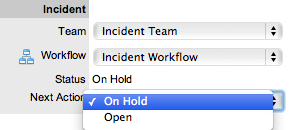 .
.Incident Workflows are a combination of any number of stages or States that cover the lifecycle of an Incident. A Supervisor creates new Incident States for the default Incident Workflow or builds new Workflows in the Service >Workflows tab. For more information about configuring Workflows. See: Workflows.
Within the Incident Information Summary page, the assigned stage of
the Workflow is displayed within the Status field, with the Next Action
field displaying the options of where the Incident can move to. To view
an assigned Workflow in its entirety select  .
.
The system provides the following States:
Status |
Description |
SLA Timers On |
|
Open |
The Incident is open. Incident timers are running and the automated SLA reminders, warnings and escalations will fire relative to the Triggers configured for the SLA. |
Open - Restored |
The Incident is still open as the issue is yet to be resolved, but a satisfactory temporary solution has been put in place. SLA triggers will fire for the SLAs Resolution Time, but the Restoration targets have been met for the Incident. |
Pending
|
Work on the Incident has not yet begun. The Response-Time SLA trigger will fire for Incidents with this Status. |
SLA Timers Off |
|
Pending - No Contract |
A valid contract is not in place and one needs to be created or processed before work can commence on the Incident. Any changes to the Status will be recorded in the History tab. |
Closed Restored |
Though the basic issue remains, a satisfactory temporary solution has been reached and the Incident has been closed. SLA triggers will not fire for Incidents with this Status. |
Closed Resolved |
The issue has been resolved and the Incident has been closed. SLA triggers will not fire for Incidents with this Status. |
On Hold |
The Incident has been put on hold for some reason. SLA triggers will not fire for Incidents with this Status. |
On Hold - Pending Approval* |
An Incident automatically moves to this State when the "Propose" button is used for sending an Incident Note. This means the CloseRequest email is sent to the Customer asking them to verify the proposed Solution. If the Customer does not respond to the email, the Incident is automatically closed by the number of days set within the Handshaking Privilege. (The email handshaking option is set by the Administrator in Setup>Privileges> Requests.)
By clicking on the URL provided in the email, the Customer ensures the Incident retains an open and active State. |
On Hold - Process Escalated* |
An Incident moves into this State when a Service Request, Problem or Change has been created within the Analysis tab of the Incident. The timer stops and there are no future States as the Incident will be closed when the related Problem or Change is closed. |
Cancelled |
The Incident has been cancelled. SLA triggers will not fire for Incidents with this Status. |
When an Incident is created and assigned the default Incident Workflow, it is automatically assigned the Default Open State defined for the Workflow. The Default Open State can be customized for the Incident Workflow within Service > Workflows.
To manually change an Incident's Status:
Select Operations > Incidents
Select the Request # hyperlink for the relevant Incident
Click Edit
From the Next Action
drop-down list select the Incident's next Status
The States listed in Next Action are based on the Incident workflow
and its lifecycle. To view the Workflow in its entirety click  .
.

Click Save.
The system can automatically move an Incident into another State through the following actions:
Using the Handshaking feature when a Note is added by selecting the Propose button to send and save a Note
Closing an Incident when adding a Note using the Solution button
Escalating an Incident to a Problem or Change Request
When Billing is enabled and payment is not received.
Incidents logged with the system that do not have a valid Contract are assigned the Pending - No Contract Status. These Incidents are locked until a valid Contract is applied, and if relevant, paid. See: Create a Contract
When Incidents move into a State with a Status Note,  is displayed beside the assigned Status within the Summary tab of the
Incident. Scroll over
is displayed beside the assigned Status within the Summary tab of the
Incident. Scroll over  ,
to view the contents of the Status Note. If the Status Note includes an
attachment, click the attachment name link in the pop-up window to download
it. Click
,
to view the contents of the Status Note. If the Status Note includes an
attachment, click the attachment name link in the pop-up window to download
it. Click ![]() to close the window.
to close the window.

SLA Triggers fire for Incidents that are in a Workflow State that have the Service Timer Active option set to Yes. The default Timer Active set for systems States can be changed if relevant for the organization. For example, it may not be appropriate for an organization to have SLA Triggers fire when an Incident is moved to the system default On Hold State.
The following icons displayed in the Service Terms box, visually indicate how the Incident is tracking against the SLA and if the SLA timers are active:
Current SLA Status |
|
|
Workflow is in an SLA paused State. Triggers will not fire. |
|
Workflow is in an SLA timers on State. Triggers will fire. |
|
Workflow is in an Exit State and the SLA has been successfully met. |
|
Assigned SLA has been breached and Workflow is in an Exit State. |
Supervisor Users can verify the Timer Active status of a Workflow by scrolling over the Status in the Workflow map available in the Summary Information screen, or within the Service>Workflows>selected Workflow> Lifecycle>selected Status screen.
